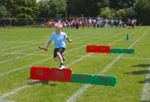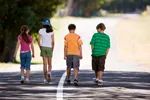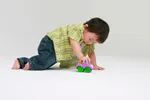Help to Life
Have you ever asked yourself the question, “What is education supposed to do?” I started asking myself this question as a young Montessori teacher and later as a mother, especially when my own children hit some challenging times in school. I have thought about it for years and read a number of authors on the subject. I read all the time in the newspapers of various recommendations for improvement in education, but only rarely does anyone ask what education really is.
It seems like just about everything in our world is changing, but the educational system is very much the same. We have gone from transistor radios and record players to tape players and televisions to high-powered computers, 70” HDTV screens and cell phones. Yet many schools today follow much the same model our grandparents had, with a teacher standing in the front of a group of children all of the same age. Today, the teacher is likely teaching the curriculum the state mandates, preparing children to pass the required tests.
My guess is that most people still think of education as the “three r’s”— reading, writing and ‘rithmetic. Most of us think of education as the facts and information we need to be able to function in our society and yes—that is part of it, but not all of it. The word “education” in the English language comes from the Latin word educere which means to lead out from within.
What are we leading out from within? In your heart of hearts, do you think today’s schools nurture the individual potential of our children? Bringing out our potential, the particular gifts that may be unique to us, seems to be the opposite of the traditional education most of us know. Conventional education in the U.S. in the 21st century is more of a pouring in of what the teachers and the textbooks want us to know rather than a release from within. There is most often a focus on giving the one specific answer the teacher wants rather than encouraging creative thinking and problem solving. Is this the way it is supposed to be?
Exploration in learning
Let’s think, for example about the number 4. Most young children are taught that it is a number in the sequence of numerals and that it represents the quantity of 4. It represents 2 + 2. That is the only correct answer for 2 + 2. But there is a lot more to be said about the number 4!
- It is the number that comes after 3 and before 5
- 1+1+1+1
- 2+2
- 3+1
- 1+3
- 5-1
- 6-2
- 7-3
- 2x2
- 2²
- 8÷2
These are just a few things symbolizing 4. But 4 also represents many other things as well:
- The number of legs on a chair
- The number of sides in a square
- Number of legs my dog has
- Number of tires on a car
- Number of seasons in the year
- The number of people in some families
If children are taught that there is one answer to a problem, they may miss the wonder of exploring many different solutions. This is the difference between convergent thinking (when we want to converge all our thinking on one single answer) and divergent thinking (when we want to open our eyes to multiple possibilities). There is a time and place for both.
Education and creativity
Sir Ken Robinson, author, advisor to governments and international expert on creativity, explains in an entertaining YouTube video (see RSA Animate “Changing Educational Paradigms”) that 98% of kindergartners are geniuses at thinking of dozens (and in some cases hundreds) of ways to use a paper clip. In other words, most of our children are born highly creative. Over the years, throughout elementary school and middle school, they lose more and more of the ability to think creatively. What is the root cause of this great decline? Sir Ken suggests that the one thing they have in common is that they become “educated.” They learn to give the “correct” answer.
Many children become bored in school. Why is that? How is this amazing, beautiful world made boring by teachers? Does it have to be this way? Are the interests of your child taken into consideration in a typical classroom? Should they be? Why are our children not becoming more creative rather than less creative? Would a change in the system of education change that trend?
What is education?
So we return to our first question: “What is education supposed to do?” Maria Montessori gave a startling answer. She suggested that education is “help to life.” Montessori education is not a specific method for any one particular age. It is not a static curriculum, but rather a dynamic way of being, a way of assisting people and especially children to become all that they are, and to do all they can do.
Every society uses education to convey basic principles and acceptable traditions of their culture. We use education as a means to prepare children to live in society. Our society is literate and uses a lot of numbers and science. So, naturally, we want our children to do well in these subjects. But if your child is not a fast reader or is not a mathematical whiz, does that mean he or she is a failure? Is there more to education than the main subjects we usually associate with school?
What if the child is an exceptional artist, a talented dancer, or a great listener that can make a dejected friend feel happy again? How can we use our educational system to help children find satisfying and successful careers doing what they can do well instead of losing confidence for what they cannot do well?
Are you stupid because you can’t find the right answer?
On a personal note, I have always been good with words but poor with math. Believe me when I tell you that I suffered over the years, struggling and feeling like a failure. If you have ever seen (or been) the child who feels stupid because he cannot do some task the teacher wants, you know what I mean. How many children bear the wounds of being unable to do certain tasks that mold their entire self-confidence or lack thereof? Is this what education is supposed to do?
In my years of teaching Montessori, one of my greatest delights has been to help children find the joy of learning something they thought they could not do, whether it was reading, math, learning the names of the states, or chemistry.
Help to life
Helping life means to observe where the child is at any given time and give him the opportunity to take the next step in development. In other words, education meets the need of the child where she is, not where she is “supposed to be.” It is the recognition that every child has genius of some kind locked within. He is the one and only person exactly like him or her! Education as help to life is common kindness and courtesy to the individual soul.
In my teaching career in Montessori, I have had the privilege of working with a wide spectrum of children. In Montessori I could meet the needs of them all. Here are some examples:
- Sprinters.
 I had a 6-year-old who was taking university courses in physics on the weekends at Johns Hopkins University. This child was in the category of what we call the “sprinters.” He was more like an Olympic sprinter! He raced through every academic challenge we gave him, from chemistry in our small classroom lab to making Pangaea out of our puzzle maps in geography. His parents wanted him to have the experience of being with his peers and he thrived in Montessori. He went on to a distinguished academic career in physics.
I had a 6-year-old who was taking university courses in physics on the weekends at Johns Hopkins University. This child was in the category of what we call the “sprinters.” He was more like an Olympic sprinter! He raced through every academic challenge we gave him, from chemistry in our small classroom lab to making Pangaea out of our puzzle maps in geography. His parents wanted him to have the experience of being with his peers and he thrived in Montessori. He went on to a distinguished academic career in physics.


- Crawlers.
 I also have had dyslexic children for whom reading and writing was a severe challenge. I have had a number of children with Down syndrome whose progress was slow but steady, and children with severe developmental delays who seemed to make little progress. I have also had children who bit, hit and kicked others. Their great challenge was getting along. The calm, non-confrontational classroom helped these children make progress.
I also have had dyslexic children for whom reading and writing was a severe challenge. I have had a number of children with Down syndrome whose progress was slow but steady, and children with severe developmental delays who seemed to make little progress. I have also had children who bit, hit and kicked others. Their great challenge was getting along. The calm, non-confrontational classroom helped these children make progress.

Whether children are crawlers, walkers or sprinters, they all move along the same path of development. Help to life is assisting and nurturing this progress each step of the way and respecting the growth and development of each one.
The gift of Montessori
The great gift of Montessori is to offer a systematic approach to helping life unfold, a system for teaching individual children with hands-on, interesting activities rather than a set curriculum that everyone has to do at the same time of the same day. Activities in the areas of practical life skills, sensorial development, language, and math help children move through developmental stages of growth with mastery and joy. Montessori helps us find a balance of helping life as well as meeting (and exceeding) academic standards.





















